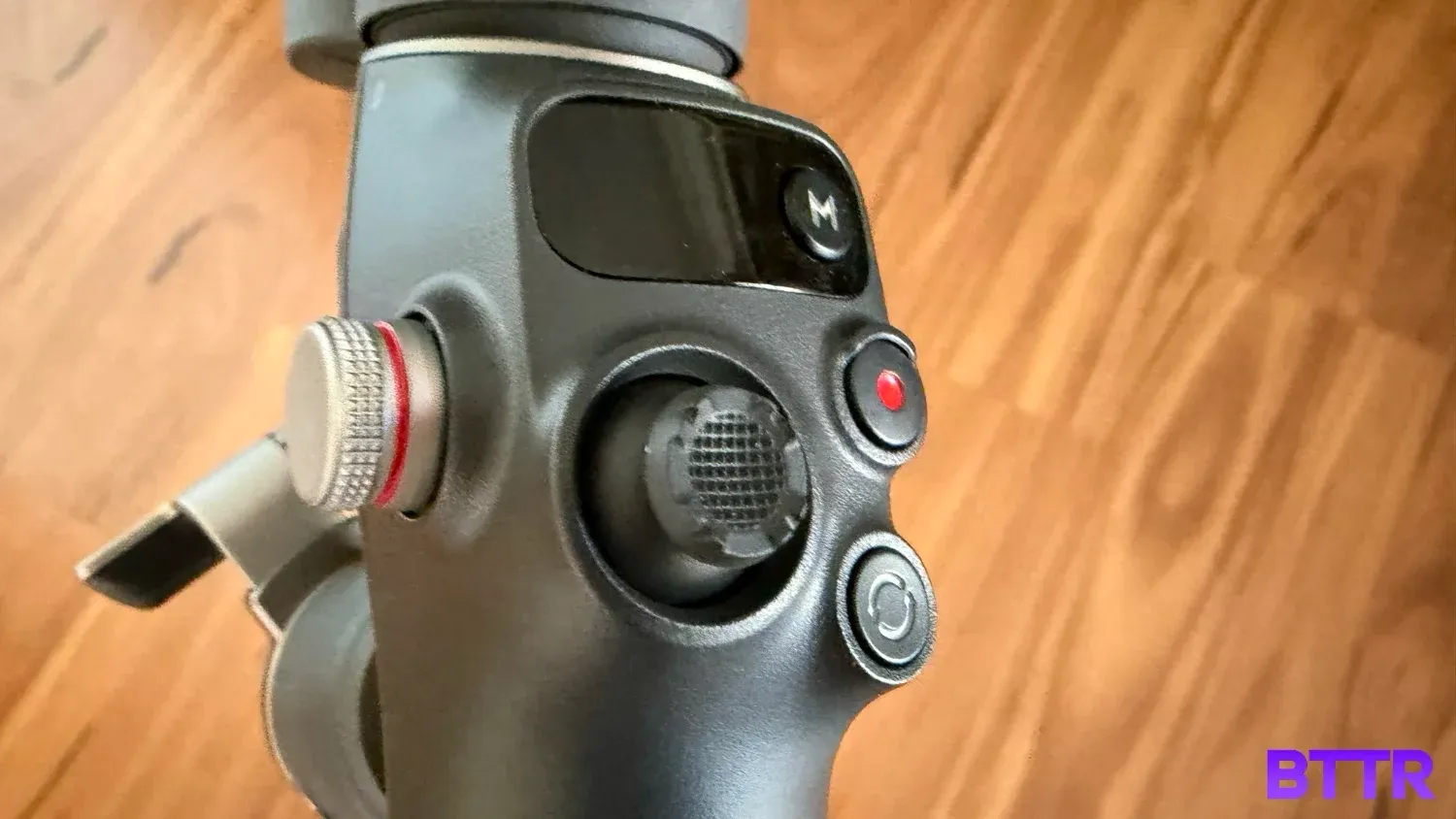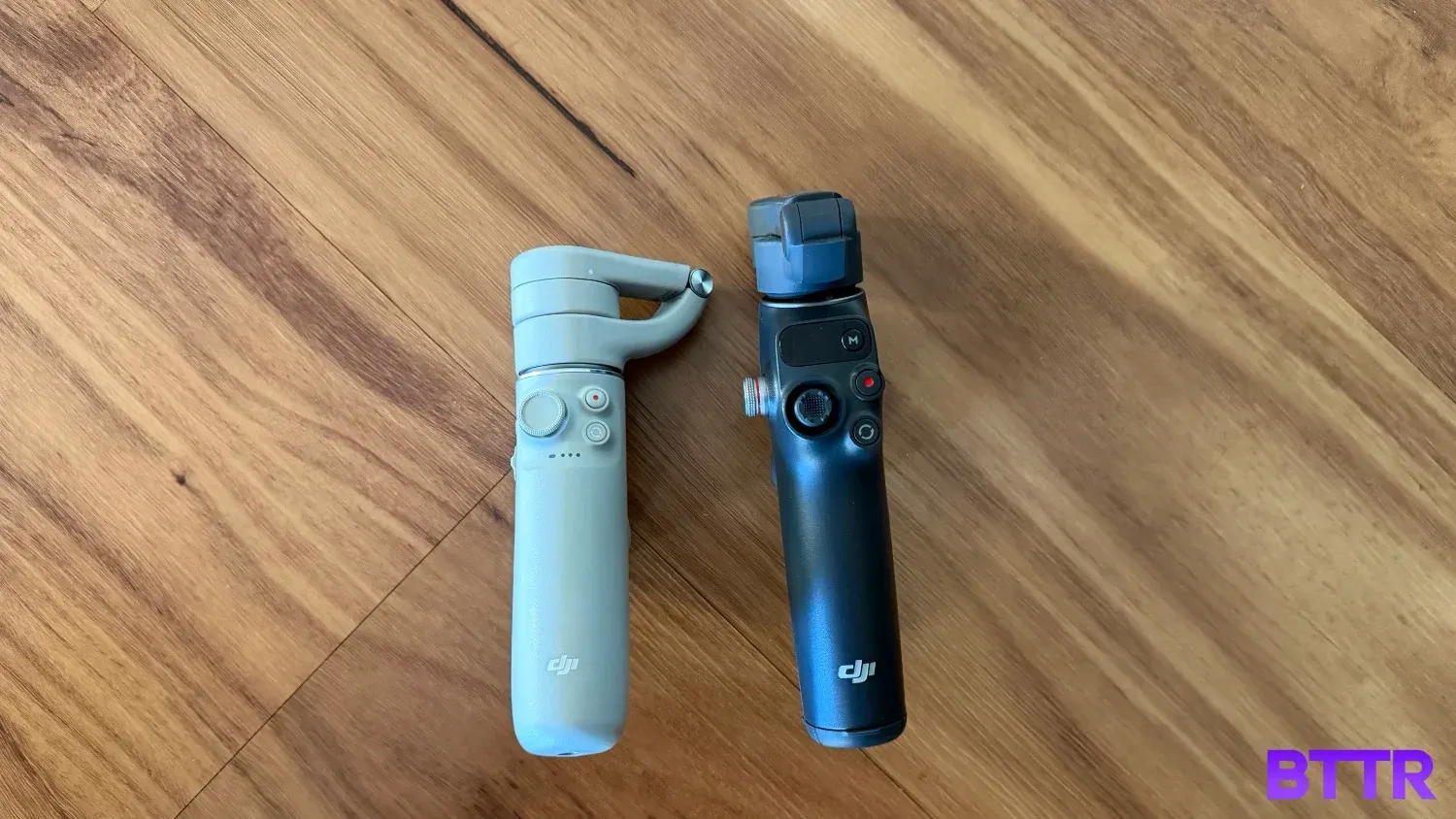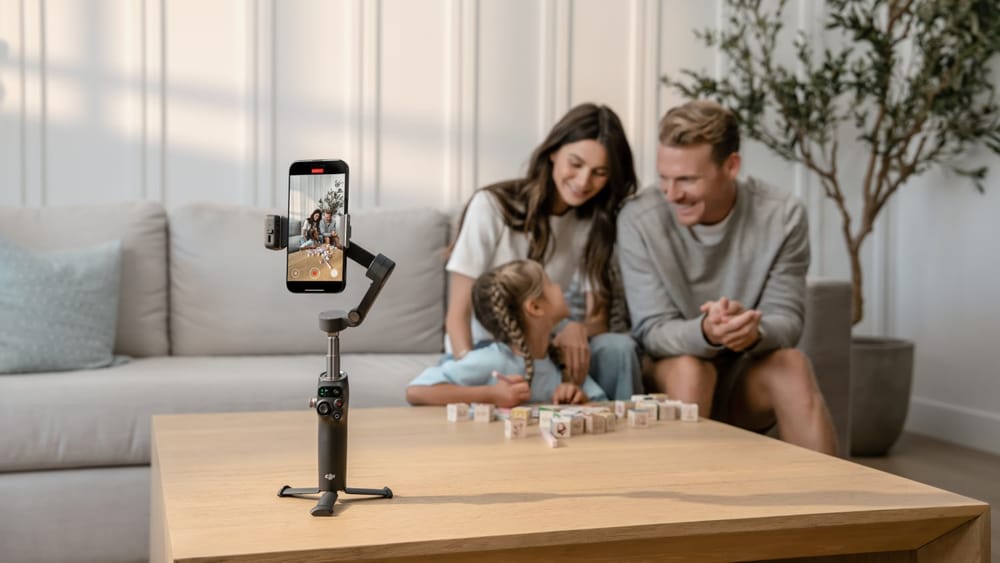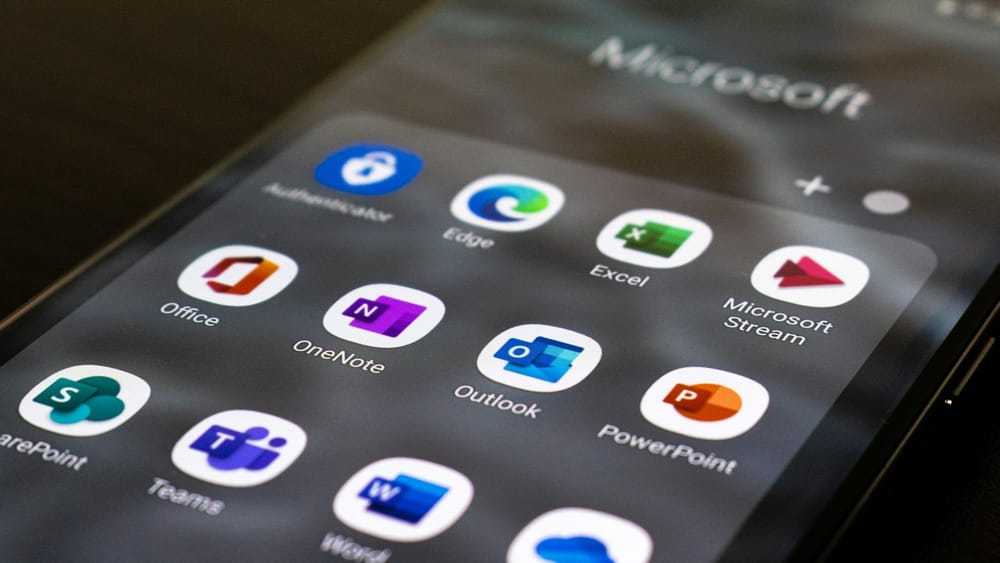The DJI Osmo Mobile 8 is a great companion for content creators wanting to easily track their subjects using their smartphone. It really elevates the opportunity for great footage, regardless of your device or camera app.
- Tracking works across apps
- 360-degree rotation!
- Built-in tripod is genius
- Need to memorise controls
- Tracking module can pop off
- Fairly bulky
I’ve been using the DJI Osmo Mobile 5 for the past few years to help me create video for the BTTR social platforms. It’s good, but lacks a few features that would make it great.
Things like an integrated tripod, or the ability to rotate a full 360 degrees horizontally. Plus, after years of use, the phone grip has started to lose its padding.
So all of these things put me squarely in the market for an upgrade. And lo and behold, along comes the Osmo Mobile 8, which improves every one of those features, plus a whole lot more.
I’ve been using the Osmo Mobile 8 for about a month, and I am not looking forward to the day it needs to go back to DJI. The auto-tracking module, combined with DockKit support and its integrated tripod, make this an essential partner to any content creator who wants to use their phone to create video.
It does have a pretty big learning curve, though. You need to remember a number of button press combinations and hand gestures to get the most out of it. But once you’ve been using it for a few weeks, those become second nature.

What makes the DJI Osmo Mobile 8 stand out?
Coming from the Osmo Mobile 5, there are a number of “new” features that make this stand out. But for anyone who invested in the Osmo Mobile 7 or 7P that launched earlier this year, some of these won’t be anywhere near as exciting.
The key upgrade the Osmo 8 has over its previous models is support for Apple’s DockKit. What the heck is DockKit? It’s an Apple Protocol that allows third-party dock accessory makers to connect with Apple’s camera apps to control the dock.
Essentially, it means that you can now get the fancy subject tracking features DJI has offered in its Mimo app for years using the default iPhone camera app, as well as social apps like Instagram and TikTok.
Even better, you can use DJI’s hand gestures to control those apps to start and stop tracking or recording.
If you don’t use an iPhone, you have to use the DJI Mimo app to track your subject using the gimbal’s OM Multifunctional Module.
This module first appeared on the Osmo Mobile 7 and 7P. Before I tried it, I actually longed for DJI to let the gimbal attach to my iPhone 16 Pro Max using a MagSafe connection. Now, thanks to the Multifunctional Module, I rarely took advantage of the MagSafe option the Osmo Mobile 8 offers (via an additional accessory).
Instead, the Multifunctional Module magnetically attaches to the grip that holds your phone, and gives the gimbal subject tracking (including pets for the first time!), a fill light with adjustable brightness and direct connection to either DJI’s Mic Mini, Mic 2 or Mic 3 transmitter.
Oh! And on top of that, the gimbal now rotates a full 360 degrees horizontally.
DJI Osmo Mobile 8 specs
| Specification | Details |
|---|---|
| Stabilisation | 3-axis gimbal stabilization |
| Pan Rotation | 360° horizontal rotation |
| Phone Compatibility | Smartphones up to 84 mm wide, 6.9-10 mm thick |
| Maximum Load | 300g |
| Weight | 370g (with accessories) |
| Battery Life | 10 hours (standard use) 5 hours (with tracking module enabled) 4 hours (with fill light at max brightness) |
| Charging Time | 2.5 hours |
| Connectivity | Bluetooth 5.3, USB-C |
| Extension Rod | Built-in 21cm telescoping arm |
| Tripod | Integrated tripod with 1/4"-20 UNC mount |
| Tracking Technology | ActiveTrack 7.0 |
| Subject Tracking | Humans, cats, and dogs |
| Apple DockKit | Yes (native iPhone camera app support) |
| Multifunctional Module Features | - AI tracking with gesture control - 40 lux fill light (8 brightness levels) - Colour temperature: 2,500K - 6,000K - DJI Mic receiver (Mic 3, Mic 2, Mic Mini) |
| Gesture Control | Palm (start/stop tracking), V sign (photo/record), Double L (adjust framing) |
| Control Features | Analog joystick, mode button, record button, zoom wheel, trigger button |
| Phone Mount | Magnetic phone clamp with intelligent sensor and automatic alignment |
| Companion App | DJI Mimo app (iOS/Android) |
| Additional Features | SpinShot mode, panorama modes, time-lapse, hyper-lapse, low-angle shooting, Apple Watch control |
| Price | $219 |

Design and build quality
The Osmo Mobile 8 is a bit bigger and heavier than the Mobile 5 I’m used to. It weighs about 370 grams, compared to 292 grams for the Osmo 5. You do feel that weight, but you get a lot more bang for your buck as well.
One of my favourite things, without a doubt, is the integrated tripod legs. If you can find a sturdy flat surface, you can now slide out the three legs from the bottom of the Osmo Mobile 8 and start recording, without having to screw in a tripod.
If you do want to use a larger tripod, you can still use a standard screw mount.
You still get a telescopic extension rod built in, which extends out 215 mm, which is plenty of space if you want to record yourself on your phone at arm’s length.
There was a brief adjustment period when I started using the Osmo Mobile 8 over the Osmo Mobile 5 to get used to the controls. While the rear trigger is located in a similar position and the main control dial, record button and rotate button are in the same spot.
But the newer model has an additional dial on the side, which is used to control the Multifunctional Module, as well as a small screen and M button that lets you adjust the control mode and monitor battery life.
I did find that the side dial didn’t really get much use from me. It was easy to adjust the fill light and colour from the Multifunctional Module itself, and once done, I rarely felt the need to touch the dial.
The whole gimbal folds down, just like previous versions, though this does feel bulkier than the Osmo Mobile 5. Depending on your needs, it could even be too bulky – you may want to consider a dedicated vlogging camera like the DJI Osmo Pocket 3, which is much more friendly from a size and weight perspective.

Performance and software
At a media event last year, another journalist commented that he struggled to get the Osmo Mobile to work (as he recorded video on a much smaller, more compact Osmo Pocket.
It’s something I hadn’t really noticed before that conversation, but now I viscerally feel the pain of the Osmo Mobile every time the gimbal rotates the wrong way, or gets stuck at the wrong angle.
The Osmo Mobile 8 is much, much better. A big part of that is the 360-degree panning, which lets you get to much more awkward angles because there’s no stop point when you’re spinning it.
But it does still get stuck in places I don’t want it to. I’m no videographer – I can barely be bothered making even simple unboxing videos – but I imagine that serious video makers would better understand the limitations of the device.
Still, the Multifunctional Module elevates DJI’s game here. The gimbal goes from dumb stabilisation stick to smart recording partner with its subject tracking and fill lighting.
And for me, DockKit was a game-changer. DJI’s Mimo software is fine, but I prefer the simplicity of Apple’s Camera app. Being able to track myself without having to load up the third-party app was a massive bonus.
While the convenience of DockKit is great, if you go straight to that, you will miss out on learning many of the hand gestures or button shortcuts you really need to know to make the most of this gimbal.
For example, you can hold up a Victory symbol with your fingers to start and stop recording. Holding up your hand, palm towards the camera, fingers slightly apart, will turn subject tracking on and off.
If you want to spin the camera around to use the rear lenses, you can triple-press the trigger. I did that a few times without realising it, and it confused me as to why it was spinning around.
And despite the simplicity of DockKit, the Osmo Mobile 8 does do more when you use the Mimo app. Remember how I said I barely used the side dial? That’s because all it did was control the lights when I was using Apple’s Camera app.
In Mimo, it can be used to control zoom and focus as well, which is useful for people trying to capture very precise shots.

Battery life and connectivity
The Osmo Mobile 8 has NFC to help you connect an iPhone for DockKit control. It took me a few times to make it work if I’m honest.
If you use an Android phone, the NFC chip can also be used to automatically launch the Mimo app, which may be useful to some people.
I appreciate the fact that the Osmo Mobile 8’s larger size means it can better handle the bulk of today’s premium phones. Where the Osmo Mobile 5 would sometimes give up when I connected an iPhone 17 Pro, the Osmo Mobile 8 handled it effortlessly.
If you have an even larger, heavier phone, there’s the option (though I didn’t test it), to add counterweights to help balance the phone as well. It’s a nice touch.
On the battery life front, DJI claims 10 hours of normal use, five hours with the Multifunctional Module working and four hours when you switch on the fill light.
I found it very difficult to track the accuracy of that, given that I used it in all different settings over the course of a month. But I did find the battery light indicator on the screen helpful in knowing when to charge the gimbal.
I also appreciate – though I didn’t really use it apart from once to test it – that you can use the Osmo Mobile 8 as a portable power pack for your phone in a pinch, by plugging it into the Multifunctional Module using a USB-C cable.

Verdict
At $219, the DJI Osmo Mobile 8 is a great way to start using your phone to record video. The combination of stabilisation and the versatility of the Multifunctional Module means your videos will be miles ahead of anything you record freehand.
It is a little bulky. And it does take some getting used to. And honestly, it’s going to be a much better solution for Apple users than Android owners (though it’s still good for anyone using Android, just saying).
But considering it’s actually a bit cheaper than the Osmo Mobile 5 when it launched in 2021, despite offering a whole lot more, I’m really impressed with the most recent model.
I do hope that DJI can somehow manage to combine a MagSafe mount with a Multifunctional Module in the next version because getting your phone in the grip isn’t as easy as popping it on magnetically.
But generally speaking, this is a bargain for anyone looking to improve the quality of their video content.
Buy the DJI Osmo Mobile 8 if:
- You want to record better video from your phone
- You would rather not spend a fortune on expensive video equipment and lights
- You use an iPhone and want subject tracking in the default Camera app
Skip the DJI Osmo Mobile 8 if:
- You need something really discreet and lightweight
- You want the full experience but don’t want to use DJI’s app
- You just want a selfie stick without the tracking features
Where to buy
The DJI Osmo Mobile 8 is available now. Pricing starts at $219 for the gimbal, which comes with the Multifunctional Module. There’s also a Vlog Combo pack that adds in a DJI Mic Mini transmitter.
You can buy the gimbal from the following retailers:
Frequently Asked Questions
What phones are compatible with the DJI Osmo Mobile 8?
The DJI Osmo Mobile 8 is compatible with most modern smartphones that are up to 84 mm wide and between 6.9-10 mm thick, with a maximum weight of 300g. This includes popular models like the iPhone 17 Pro Max, Samsung Galaxy S25 Ultra, and Google Pixel 10 Pro. The magnetic phone clamp features intelligent sensors for automatic alignment and secure mounting.
How long does the Osmo Mobile 8 battery last?
The DJI Osmo Mobile 8 offers up to 10 hours of battery life under standard use. When using the ActiveTrack module continuously, battery life reduces to approximately 5 hours. If you're using the fill light at maximum brightness, expect around 4 hours of runtime. The gimbal fully recharges in about 2.5 hours via USB-C.
Does the Osmo Mobile 8 work with the native iPhone camera app?
Yes, the DJI Osmo Mobile 8 supports Apple DockKit, which means it works seamlessly with the native iPhone camera app and other third-party camera apps on iOS. This allows you to use ActiveTrack 7.0 subject tracking directly within your preferred camera app without needing to open the DJI Mimo app. Android users will need to use the DJI Mimo app for full functionality.
What is the ActiveTrack 7.0 feature, and what can it track?
ActiveTrack 7.0 is DJI's latest AI-powered subject tracking technology that automatically keeps your subject in frame. The Osmo Mobile 8 can track humans, cats, and dogs with impressive accuracy. The tracking module uses AI vision sensors and can be controlled using hand gestures like a palm gesture to start/stop tracking, a V sign to take photos or start recording, and a double L gesture to adjust framing.
Can I use the DJI Osmo Mobile 8 as a selfie stick?
Absolutely. The DJI Osmo Mobile 8 features a built-in 21 cm telescoping extension rod that transforms it into a stabilised selfie stick. This makes it perfect for vlogging, group photos, and capturing wider angles. The gimbal also includes an integrated tripod for hands-free shooting, making it versatile for various content creation scenarios.
Is the DJI Osmo Mobile 8 worth it compared to the Osmo Mobile 6?
The DJI Osmo Mobile 8 brings several upgrades over the Osmo Mobile 6, including the new ActiveTrack 7.0 with AI tracking module, Apple DockKit support for native camera app integration, an improved fill light with adjustable colour temperature (2,500K-6,000K), and compatibility with DJI Mic systems. If you frequently create content and want the latest tracking technology and wireless audio integration, the Osmo Mobile 8 offers substantial improvements that justify the upgrade.





